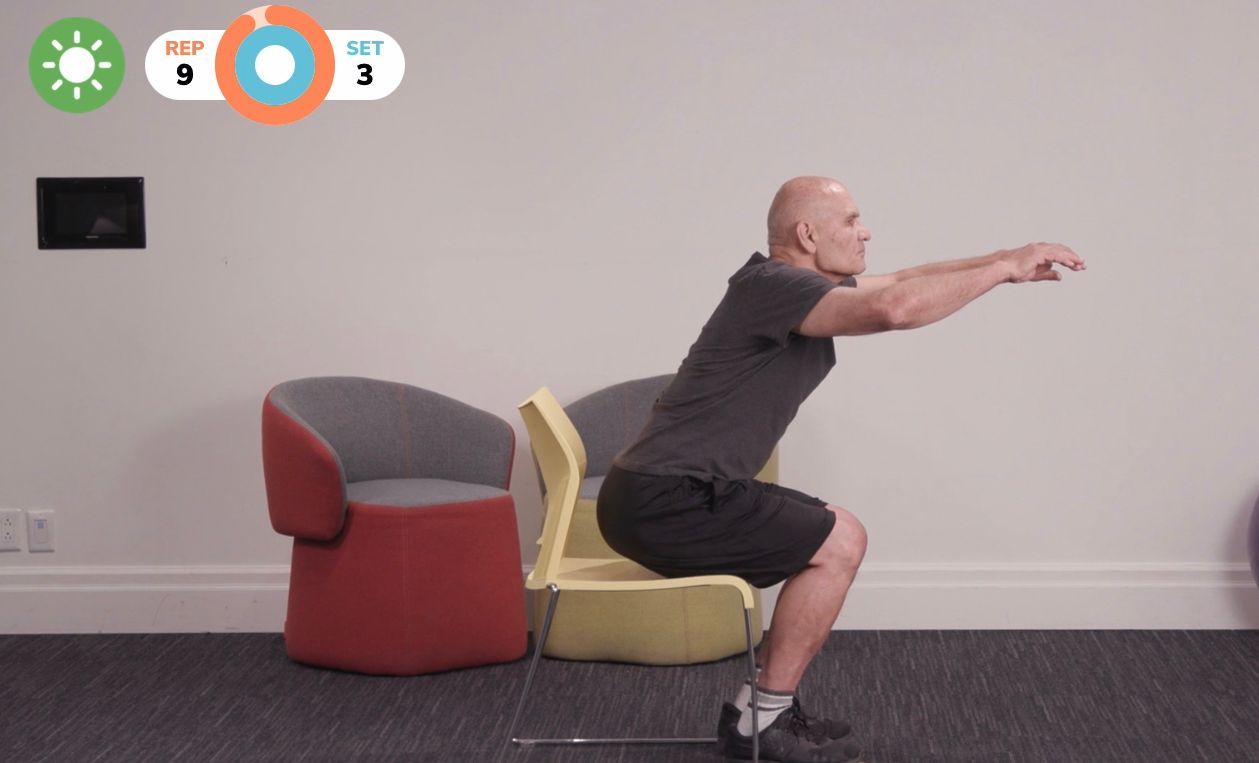Did you know that in Canada, falls are the leading cause of injuries in older adults and a fall for an older adult can actually lead to death?[1] This is because when an older adult falls, oftentimes it results in a broken bone which becomes more and more lethal as you age.[1] The more you fall and break bones, the more likely you become to keep falling and breaking bones.[1] At Curovate, we want to educate people about issues like these so that we can do our part to preserve the health of older adults in Canada and globally.
In this article, I will showcase 7 exercises you can do at home every day that will improve your balance and mobility which will reduce your likelihood of falling! All of these exercises, as well as additional fall prevention information and balance exercises, can be found in our Curovate app for older adults following knee replacement and hip replacement. Find the app links at the end of this blog. Be sure to also check out our other related blogs, such as tips to prevent falls after knee & hip replacement & ACL surgery.
1. Bridges With Alternating Leg Raises
This exercise targets your lower back, hip extensors, and hip flexors. Strengthening these muscles in your hips and thighs will help to maintain your balance by giving you greater control of your sway forwards and backwards. One study found that this exercise helps to improve your coordination, as well as your balance while sitting.[2] Complete 10 repetitions and 3 sets, where 1 repetition is lifting up (or bridging) then straightening your right leg, lowering your right leg and repeating with your left leg before returning to the starting position.
2. Front-Lying Hip Lifts
This exercise targets your hamstrings and glutes, the muscles at the back of your thighs and hips, which are crucial to maintain hip stability and to help keep your posture in an upright position, as opposed to slouched or generally forward-leaning position. This is backed up by a Belgian study that looked at how your hamstrings and glutes contribute significantly to maintaining your balance while walking and standing still.[3] Complete 12 repetitions and 3 sets per leg where 1 repetition is lifting the leg up away from the ground as far as you can, releasing back down and repeating with your other leg. Having a pillow under your stomach, as you see above, helps while doing this exercise.
3. Standing Side Leg Raises
This exercise will train the muscles that are mainly responsible for your hip stability from side to side, known as Hip Abductors. A study published in the Journal of Sports Medicine found that when your hip abductors get tired there’s an increase in your sway from side to side as well as front and back, making you less stable and more likely to fall.[4] Trust me, you’ll want to train these muscles! Complete 12 repetitions and 3 sets per leg where 1 repetition is raising your leg to the side as high as you can, lowering it back to the ground and then repeating with the other leg. Use a stable surface for support while you do this exercise.
4. Ball Squeeze While Lying
This exercise targets what are called the Hip Adductors. Hip adductors are key to maintaining your balance, especially when walking, standing still, or standing on one leg. A 2018 study of older adults found that your hip adductors contribute primarily to your ability to maintain your balance while standing still.[5] Complete 12 repetitions and 3 sets where 1 repetition is squeezing the ball as hard as is comfortable and then relaxing the legs.
5. Chair Squats
Chair squats are a great alternative to regular squats for someone struggling with their balance because there will always be support right behind them to catch them if they start to fall backwards. Even just squatting your body weight, with proper form, will improve your muscular strength and can improve your balance.[6] Complete 12 repetitions and 3 sets where 1 repetition is to stand straight up out of the chair and then sit right back down. Make sure the chair is stable and will not slide away from your body as you sit down.
6. Side Step Walking With A Resistance Band
This is another activity that targets the hip abductors, but in a slightly more demanding way because of the way the exercise bands add resistance to what you are doing. Again, you don't want these muscles to get tired easily so you'll want to keep them fit for the sake of your balance. This point is further backed up by a study from 2019 that highlights the "critical importance of the hip abductors/adductors in balance during all phases of standing and walking".[7] Complete 12 repetitions and 3 sets where 1 repetition is to walk sideways 5 feet in one direction and 5 feet sideways back the other direction.
7. Static Lunges
If you are already unstable, you may find it difficult to complete a full set, and this is when we recommend you do this activity while holding onto a surface. Lunges train the muscles of your thigh and hip including your quads, hamstrings, and hip extensors. A study of elderly women players found that a lunge-based training program increased muscular strength and improved balance as a result![8] Perform 10-12 repetitions for 1-3 sets.
Conclusion
Overall, there are many exercises and training programs out there that can improve your balance and lower your risk of falling. These 7 exercises I’ve listed are a very good starting point for anyone who wants to begin taking steps to be more stable because they have been tested in many studies and have shown to improve your balance and coordination in varying ways.[2-8] Our Curovate physical therapy app showcases all of these exercises and many more that can and will help you on your journey to achieving stability! The app also provides you with physical therapy videos and allows you to measure your knee or hip range of motion. Find our app links below for your knee replacement and hip replacement recovery which includes these and many more falls prevention exercises! Experience for yourself why Curovate is one of the best physical therapy apps on the market.
If you need further customized assistance during your surgery or injury recovery check out our Virtual Physical Therapy page to book your 1-on-1 video session with a physical therapist.
 |
 |
|---|







